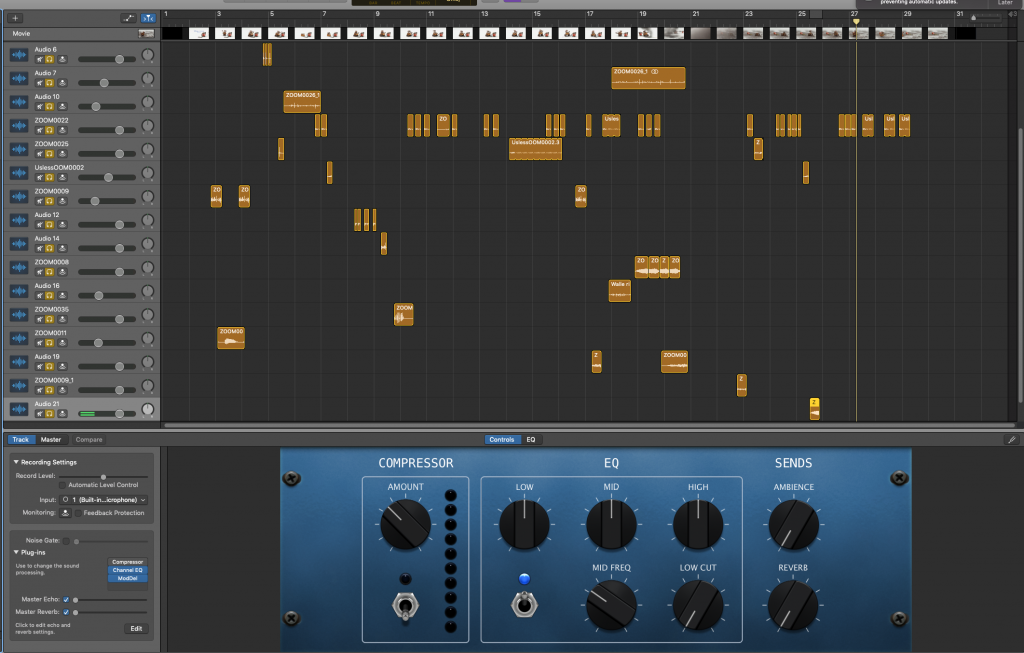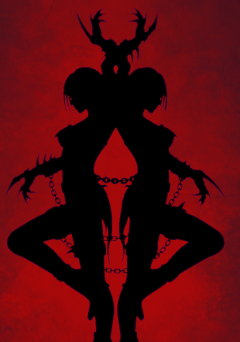Research
In my research I found bunch of interesting things for example if I need robot walking sounds I could use DVD player door closing, it will give you a motorised sound ending with a thud. You can then mix in the sounds of the surface the robot is walking on (Brooker, 2020)
Also, during my research, I found a teacher explaining how you can get a robotic sound basically from anything he used words to show it, he used words “word” and “and” he edited them to sound like robotic movement. “The first thing I wanted to do here was make the vocal clip longer, much longer. To do this I had to use a heavy dose of time stretching. I used Logic’s ‘˜In line” then he explains on how he did that he says that we need to Simply grab the end of the audio region as if you were about to re-size it, hit Option and drag it out to the required length. Later he also tells us how to add some processing he explains it as tying the whole thing together and to make the whole thing sound edgier, more robotic, and add some space.(Volans, 2020)
sadly the software we use doesn’t have time stretching and Logic’s ‘˜In line so i cant really use it which is disappointing because i had moments when i needed to stretch my audio.
One more thing I found is a description on how you can do certain stuff, more specifically Sidechaining which is a powerful sound design weapon. Create movement in your ambient drones by setting up a ‘ghost’ sidechain trigger hit (ie, one that’s routed to a compressor’s sidechain input, but not your project’s audible output), then use this to get a pad moving in intricate ways. Dedicated plugins such as Cableguys’ VolumeShaper 4 take this concept to another level, allowing you to set up rhythmic movement that can be taken up to speeds in the audible frequency range, for FM-like buzzing and grunge. And another thing they say is that it’s a good idea to record everything because you can use anything for sound design(18 expert sound design tips and tricks, 2020)
Way to improve on sound design
1. Play with pitch-Try pitching everything up or down! It’s the easiest and fastest way to take sounds away from their original context, generate new harmonics and mangle up a signal beyond all recognition. (Music, 2020))
2. Be disorderly – Re-order effect chains for creative gains – plugins and DAWs are making processing more hands-on than ever. A distortion plugin will affect a reverbed signal; a pitch-shifter will influence a compressor; and a vocoder will definitely influence the effect of a reverb. (Music, 2020)
3.Break the rules – If you’re trying to transform source sounds to the extreme, throw the usual production rules out of the window. Compress the living daylights out of something to generate obvious pumping artifacts. Strap a vocal processor across your drum mix, or assign a bass enhancer to your synth buss. Boost a bass end by +20dB to amplify some low rumble contained within a signal. Use extreme resonance settings when filtering or EQing. Push feedback dials up to 11. Distort the hell out of anything and everything. If it sounds good, then it is good! Try rearranging effects in the plugin chain, too. Just watch your gain staging, as it’s easy to get carried away and clip your DAW’s master fader or a plugin’s internal circuitry. (Music, 2020)
4. Get in tune – As the harmonics within a sound determine its pitch, you can analyse any given signal and work out its key, making it easy to tune a specific sound within a melodic composition and create something that fits the track in a musical sense. Melodyne is a popular vocal tuning solution, but it can also analyse and correct the key of any sound.
Alternatively, use a frequency analyser plugin to determine the frequency of prominent harmonics. You can then use pitch shifting techniques to get things tuned. Voxengo’s free SPAN or MeldaProduction’s MAnalyzer even display a harmonic’s musical pitch when you hover over it. (Music, 2020)
1. Set aside the time – Great sound design can’t be rushed, so before you do anything, set aside some time to do it – regular sessions, if you can. Follow the example of top sound designer Junkie XL, who sets aside every Sunday purely to create sound.
Okay, maybe that’s a bit lavish – if you’re anything like us, Sundays are about eating and drinking as much as you can – but if you plan dedicated sessions for creating sound, as you probably already do for creating music, then you’ll find that those music-making sessions flow so much better when you use the original ingredients your sound-design sessions have.(Jones, 2020)
2. Start with something simple – You’ll be surprised what you can do with basic ingredients. Start out with something simple – a small sine-wave snippet, kick or snare drum – and simply loop, process and affect it with the tools in your DAW, one by one.
Not only will you discover more about the tools at your disposal, you’ll probably use effects you’ve never explored before and you’ll start to realise how limitless your sound-design options really are. It’s a scattergun approach, but you’ll learn more about your effects and processors by applying them to something simple. (Jones, 2020)
Sound designers and composers begin their work by studying the script, gathering as much information as they can about any sound or music it calls for. As in all other aspects of design, an early meeting with the director and the design team is essential to get a clear understanding of the production concept.
Some directors will already have very clear ideas about what the sound effects and/or music should sound like, while others may request that the sound designer/composer sit in on rehearsals to assist with developing effects and music to fit the specific contexts in which they will be used.(Agarwal, 2020)
David Sonnenschein provides helpful tips, which sound designers should consider when reading film scripts for the first time. There are certain things in script one should look for. This way it is possible to crate a plan for sound design and to incorporate sound into a film. Sonnenschein suggests watching out for “objects, actions, environments, emotions and transitions” (2001: 3). (Müller, n.d.)
What does a sound designer do?
The person directly in charge of crafting a film’s sound design is, you guessed it, the sound designer. On a particularly small production, the role of the sound designer may be all-encompassing. They might serve as the only person responsible for a film’s entire audio component.
On larger productions, the sound designer typically leads an audio team consisting of a combination of some or all of the following sound design jobs: Foley artists, Audio Engineers, Re-recording Mixers, Dialogue Editors, Supervising Sound Editors, ADR teams, Music Editors and Supervisors, and even Composers.
The vast majority of a sound designer’s work is done during Post-Production but that does not mean the best film sound designers cannot be involved in a film as early as the Pre-Production stage.(Kench, 2020)
Why is sound design important
Film is made of different parts, including story, settings, actors, the production design, and many others. Often overlooked by many movie viewers is sound, which is actually very essential to film making.
Taking out the audio track will show how important sound design is for a film to work as it is intended to. Films depend as much on audio as it does on the footage to convey the over-all emotion of the story.
In other words, how good you make sound design can be instrumental to making your film good or bad. For you to grasp its full importance to film-making, here are some points on the importance of sound design to a film.(The Importance of Sound Design in Film – %%, 2020)
The Importance of Video Game Audio It only takes a few seconds of playing your favorite game on mute to realize how important sound is when it comes to creating a captivating experience.
From basic sounds like a gun reloading to iconic jingles like when you solve a puzzle in any The Legend of Zelda game, sound effects are there to make the virtual characters, stories, and worlds we are playing come alive.
Much like films and television shows, music is also very important in video games and is often one of the most beloved elements of our favorite titles.
Long after we’ve set aside the games that made up our childhood, just hearing their soundtrack again years later can fill us with joy and nostalgia.(Video Game Sound Design | Beginner’s Guide, 2020)
Why Is Sound Design Important in Theatre? Moving an audience to feel a particular way is important to keep their attention. Different sounds one hears are commonly associated with various moods and emotions.
The right combination of sounds can be created suspense and fear, while others can influence an audience to feel excited and celebratory.
Slower tempos can be saddening this, while heavy beating drums can suggest that tragedy is in the air. It can heighten the mood and enrich the atmosphere.(Why Is Sound Design Important in Theatre? | Arts Scene, 2020)
In all of the videos sound designers talk about how they work and what they did to accomplish certain things but every one of those videos is in different things for example the Score and soundtrack is about music in the game CyberPunk 2077, as the sound engineer is how sound designers work in theatres
So in the video about arch motorcycle video they talk about how they recorded car sounds for the game, the sound designers had a lot of help form car engineers so they could get the best sounds, they had the whole car covered in mics, in the engine, exhaustion pipe and bunch of other places to get the best sounds possible. also they recorded bunch of cars so it wasn’t one car they recorded somewhere about 30 different cars.
In the sound engineer video Carin Ford talks about how she works and how the sound design is used in theatres, for example she needs to check all of the speakers to know if anything is malfunctioning, during the play she needs to keep her focus on all of the sounds just in case one of the actor microphones stop working or anything like that, and in my opinion the theatre sound design have it the hardest because they are live preforming, so if something goes wrong they might have some problems and they need to fix them so no one suspects a thing. in that case movie and game sound designers have it easier because they are not working with live preforming where they have to stress because they have more time to fix everything.
In the transformer video Jeff Haboush doesn’t really talk about how they made the sounds but mostly about the technology they used for example he mentions how they got this thing to control the distance on how far the sound travels.
but in all of the videos they explain how its pretty delicate work and that the timing needs to be near perfect if not perfect, and that all the sounds need to work together to make you feel the sound and to get you more interested in the movie, game or what ever it might be.

Sound Design, Wall-E video evaluation
Well the first thing I realised about sound design is that you should note down or memorise the video, you are going to work on because it’s really hard to find sounds for a video you don’t know and it makes your work a lot more difficult if you have bunch of random sounds. also i should try to get a group that will do the work instead of messing about in the background disturbing the sound recording
Another thing I learned is that you should name all the sounds you have so its easier to work with them and also try to organise them.
One annoying thing I learned is that you need to be extremely careful with the placement of the sound so it follows the video really well for example if I have a video of a cup getting smashed I need to have the sound right when the cup smashes not a second later or faster it needs to be spotless so no one can see the editing that has been done
One thing I found out is that even though you might have sounds that wouldn’t fit in with the video you can edit them to make a different sound completely although you need to be careful because the sound you make could be extremely loud.
When I was looking for sounds, I used things like radiators, doors and even pencils and most of the sounds were used in my practical work, and some things I didn’t exact to use as well for example our teacher explaining who to use the recorder.
Also, I needed to cut a lot of the sounds up to get the sound I wanted for example when Wall-E’s eyes move I had to cut the sound up multiple times before it was in time with the video.
When I was doing my research, I found a lot of ways to make sounds for example I found a video where people where using shrubs to make thunder sounds, sadly I cant find the video anymore but they also used coconuts to make horse running sounds.
Next time I would learn the video and note down the moments and the things happening around so a know what sounds I need and spend a-lot more time recording the sounds because some of them had background noise which made them harder to use, also I would spend more time thinking how to edit the sounds to get different ones, also if there’s a group of us we could get people to get different sounds for example some might be looking for a technical sound while someone else for something that sounds like wind. and like i mentioned before it should be a group of people that will do the work instead of messing about.
After more research I can say that we need more time to record the sounds and that we need to know the video or whatever we are making the sound for really well, and also we should break the rules for example record something that is nothing close to the sound we want, because we can manipulate the sound to make the sound we want, also we defiantly need multiple people doing different things like I mentioned before, so one person looks for don’t know walking sounds while someone for voice lines, this way we make everyone’s work easier because no one needs to stress out about all off the sounds. Next we need have some idea on how to edit the sound so we can make different sounds and get the sound we want, with voice it’s easier especially for robots because everything we need to do is use a plugin called “ModDel” and set it to resonator high, off course it doesn’t mean it will work every time and it might take some tweaking but its defiantly a start, plus you can use this plugin for a lot of robotic sounds but like I said it might take some fixing to get it the whey you want.
so i can say for the ending that i definitely will note down everything for the next project i do, also if I’m in a group ill defiantly will try to get one person for certain sounds so we all can get sounds easier, also i’ll definitely will learn how to edit the sounds in more detail so it’s easier to use any random sound as well also think that we need some sort of music in the back just to make the videos feel a bit more alive as well.

Bibliography
Brooker, I., 2020. Walking, Robotic Hydraulics / Footsteps | Epic Sound. [online] Epicsound.com. Available at: <https://www.epicsound.com/2013/04/walking-robotic-hydraulics-footsteps/> [Accessed 24 November 2020].
Volans, M., 2020. Creating Robotic, Machine-Like Sound Effects In Logic Pro. [online] Macprovideo.com. Available at: <https://www.macprovideo.com/article/Synth-Sound-Design/creating-robotic-machine-like-sound-effects-in-logic-pro> [Accessed 24 November 2020].
MusicRadar. 2020. 18 Expert Sound Design Tips And Tricks. [online] Available at: <https://www.musicradar.com/tuition/tech/sound-design-tips-and-tricks> [Accessed 24 November 2020].
Music, F., 2020. 7 Ways To Improve Your Sound Design Skills. [online] MusicRadar. Available at: <https://www.musicradar.com/tuition/tech/7-ways-to-improve-your-sound-design-skills-603459> [Accessed 1 December 2020].
Jones, A., 2020. 10 Essential Tips And Tricks To Creative Sound Design. [online] MusicTech. Available at: <https://www.musictech.net/guides/tips-on-creative-sound-design/> [Accessed 1 December 2020].
Agarwal, R., 2020. What Is Sound Designing & The Role OF Sound Designer. [online] Audioshapers.com. Available at: <https://www.audioshapers.com/blog/what-is-sound-design.html> [Accessed 1 December 2020].
Kench, S., 2020. WATCH: How Tarantino Makes Violence So Much Fun — Sound Design Ultimate Guide. [online] StudioBinder. Available at: <https://www.studiobinder.com/blog/what-is-sound-design-for-film/> [Accessed 1 December 2020].
The Best 3D Animation CGI And Filmmaking School In Cebu. 2020. The Importance Of Sound Design In Film – %%. [online] Available at: <http://www.filmmediaarts.com/blog/the-importance-of-sound-design-in-film/#:~:text=A%20film’s%20sound%20design%20cleans,have%20extraneous%20information%20like%20noise.> [Accessed 1 December 2020].
The Ultimate Resource for Video Game Design. 2020. Video Game Sound Design | Beginner’s Guide. [online] Available at: <https://www.gamedesigning.org/learn/video-game-sound/#:~:text=Since%20many%20composers%20are%20outsourced,any%20audio%20bugs%20or%20mistakes.> [Accessed 1 December 2020].
Artsscene.org. 2020. Why Is Sound Design Important In Theatre? | Arts Scene. [online] Available at: <http://www.artsscene.org/sound-design-important-in-theatre/> [Accessed 1 December 2020].
Müller, B., n.d. Sound Design. diplom.de, 2008, p.71.
Corki Gaming, 2014. [online] Youtube.com. Available at: <https://www.youtube.com/watch?v=T4H4ZrgYDz8> [Accessed 8 December 2020].
Cyberpunk 2077, 2020. [online] Youtube.com. Available at: <https://www.youtube.com/watch?v=H4cIgzh9tEg> [Accessed 8 December 2020].
Cyberpunk 2077, 2020. [online] Youtube.com. Available at: <https://www.youtube.com/watch?v=SM-7tygacE8> [Accessed 8 December 2020].
American Theatre Wing, 2020. [online] Youtube.com. Available at: <https://www.youtube.com/watch?v=8gVcVnVnQu8> [Accessed 8 December 2020].

